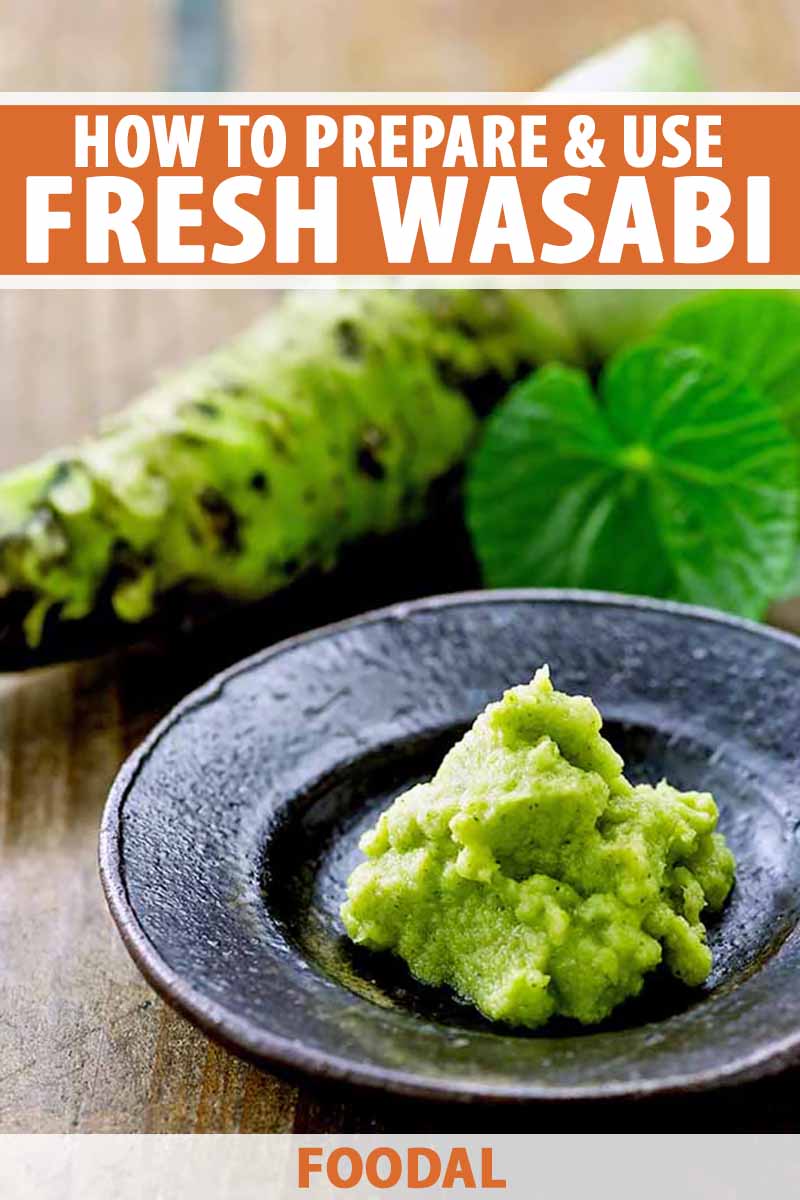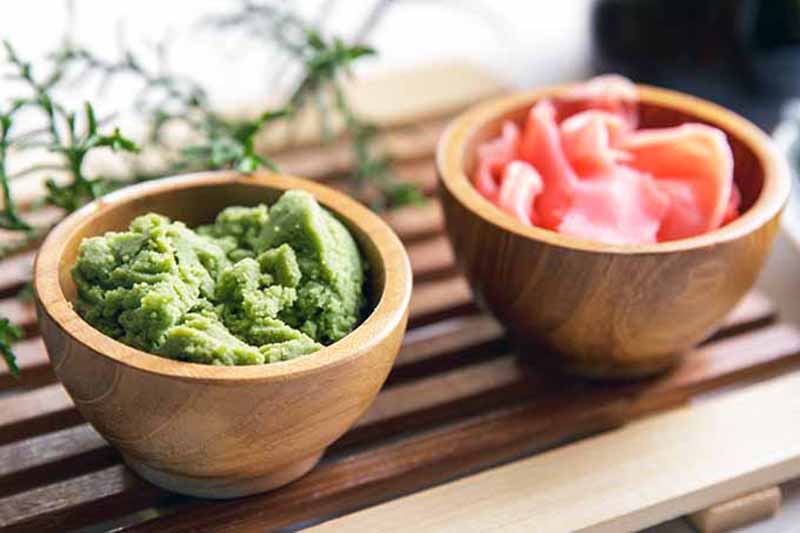We occasionally link to goods offered by vendors to help the reader find relevant products. Some of these may be affiliate based, meaning we earn small commissions (at no additional cost to you) if items are purchased. Here is more about what we do.
What’s green, pungent, and spicy all over?
Give up?

It’s wasabi, the popular green condiment that makes its way onto every sushi plate, right next to the pickled ginger. But it’s far more than just a green blob that you’re too afraid to eat!
It is an extraordinary rare plant that has fresh, vibrant flavor and a strong punch of spice that wakes up any dish.
Continue reading to learn more about our favorite Jolly Green Giant of flavor! We’ll tell you how to buy, prep, store, and use this phenomenal plant!
Spicy Wasabi: A Rare Rhizome with Huge Flavor
The Basics
This prized ingredient belongs to the Brassicaceae family, which is also the same family as horseradish, in addition to mustard plants and cruciferous vegetables like cabbage, broccoli, and kale.

It is an extremely rare plant – while it is cultivated in several countries across the globe, the wild variety grows in Japan, near the shores of natural creeks and mountain streams, and takes several years to reach maturity.
The root-like enlarged rhizome, which is the stem of the plant, is the main component in demand for culinary uses, though the roots and leaves are also edible.

It shares similar volatile compounds as horseradish, but it has an even more intense aroma and flavor.
However, the pungency lasts no longer than 30 minutes once the flesh is exposed due to cutting or grating.
Potential Health Benefits
A 2000 study by Naohide Kinae et al. by the School of Food and Nutritional Sciences at the University of Shizuoka explained that the potent component allylisothiocyanate found in both wasabi and horseradish may inhibit the growth of fungi and bacteria known to cause food poisoning.

Many argue that this is the reason why our favorite spicy green condiment is traditionally served alongside sushi, as it may minimize the potential risk of a food borne illness from consuming raw fish.
Despite this health claim, a hefty dollop of bright green paste next to your sushi plate or sushi bowl should not be an excuse to consume raw seafood if your immune system is compromised, or for pregnant women, the elderly, and young children.
Buying Your Rhizomes
If you do have the chance to get your hands some fresh stems, don’t hesitate!

It’s usually on the expensive side since it is so rare, but experiencing this specialty ingredient is sure to be a rewarding experience.
Since it is such a rare plant, and due to its fleeting flavor and aroma, you will most commonly find ground powder or a ready-made paste in grocery stores, rather than the fresh rhizomes.
Although these products do not quite reach quality levels of the genuine article, this has become the main way that the majority of us around the globe are able to benefit from its characteristic taste.
Unfortunately, most of them aren’t made with actual wasabi – the main ingredient in the powders or pastes you buy is typically horseradish.

Make sure to take a look at the list of ingredients to avoid being misled.
Interested in learning more? Read our article comparing horseradish and wasabi, and how horseradish is used as a common replacement.
Prepping
If you did find the fresh plant (yay for you!), you need to prep it carefully.

Even though it has an incredible pungency capable of defeating Superman himself, it is only temporary.
When you grate the fresh variety for your dish, its strong aroma and flavor will only last for 20 to 30 minutes.
Instead of grating it ahead of time, you should always prepare the fresh product immediately before serving.
Unlike horseradish, you should not remove the skin from the stem prior to grating, as it contains a lot of flavor. Just be sure to thoroughly clean the skin, and remove any small knobs around the main stem with a sharp knife.
To get the most of this rhizome’s unique pungency, it needs to be grated with a sharp grater that has very small teeth. A microplane is a great tool to use, but its narrow shape is not the absolute best for this purpose.
It should be grated in a slow, light, and circular motion to gently release its intense compounds. There are other specialty graters available with wider shapes specifically designed for grating it in this fashion.

A traditional tool for grating this rhizome is a grater made with real shark skin, which helps to break it down into a very fine, paste-like consistency.
While considered the best option to yield the finest consistency, shark skin is not the only available style. Wasabi graters can be purchased in other materials such as stainless steel, ceramic, and plastic.
With its fine, sharp teeth and large surface area, the circular ceramic grater style remains stationary on the kitchen counter, and is a useful option to have in your kitchen. This 3.5-inch model from Kyocera is available on Amazon now.

Kyocera Advanced Ceramic Grater, available on Amazon
It can also be used to finely grate other food items – try it with horseradish, ginger, hard cheese, turmeric, or chocolate!
Proper Storage
Store this rhizome in the same way as you would horseradish:

Tightly wrap it in plastic wrap, and store it in the vegetable drawer of your refrigerator for up to a few weeks. It can also be stored this way in the freezer, and grated while frozen.
For both refrigerator and frozen storage, when you are ready to prep it again, remember to remove a thin layer of the dried or browned area that you cut previously to reach the unexposed flesh.
When storing the powdered version at home, keep it properly sealed and only mix it with water right before you plan to use it.
Otherwise, it will lose a lot of its hot flavor, just like the fresh variety will. Open and then seal the tube or package quickly and thoroughly.
Cooking and Serving Tips
In general, you can combine the genuine fresh ingredient with the same ingredients and dishes that you may enjoy horseradish with.
But keep in mind that this ingredient is more intense, and should be used carefully.

It’s always a better option, and a lot easier, to add some more later than it is to reduce the heat afterwards.
If you have overdone it on the spice, take a look at our tips to turn down the heat, where we share our advice for easy ways to save an overly spicy dish.
To give you some additional ideas for using it at home, we have collected a few of our top suggestions:
- As a fun component to a sushi bowl
- To flavor seafood, especially salmon, tuna, or shrimp
- To spice up Asian and Japanese-inspired dishes
- Alongside tomatoes or cucumber
- As an ingredient in salad dressings or dips
- Mixed into soups
The Ultimate Spicy Sidekick
Now that you know all about the plant behind your favorite green paste, make an effort to try and find the fresh rhizomes near you!

You may need to go on a little bit of an expedition outside of your own hometown grocery store, but it is so worth the trek to find the fresh variety!
The vibrant pungency and flavor from the freshly grated rhizome is definitely a rare culinary treat that you should try at least once to gain an unforgettable sensory experience!
If you like it as a fiery condiment next to sushi, or as an essential ingredient in Japanese-inspired dishes, this spicy stem is your ultimate companion.
Have you ever used the fresh variety before? How do you like to use it in dishes? Let us know all about your own escapades with this rhizome in the comments below!
Read more about creating your own unique flavor ideas with our other helpful articles that profile ingredients, specifically all of our herb and spice guides! Read these next for further tasty inspiration:
- Ultimate Guide to Kitchen Herbs and Spices
- The Scoop on Szechuan Peppercorns
- Pumpkin Spice is Everything Nice
© Ask the Experts, LLC. ALL RIGHTS RESERVED. See our TOS for more details. Originally published on July 19, 2017. Last updated on January 25, 2023. Significantly revised and expanded from an original version written by Nina-Kristin Isensee. Uncredited photos via Shutterstock. Product photos via Amazon.
The staff at Foodal are not medical professionals and this article should not be construed as medical advice. Foodal and Ask the Experts, LLC assume no liability for the use or misuse of the material presented above. Always consult with a medical professional before changing your diet, or using supplements or manufactured or natural medications.
About Nikki Cervone
Nikki Cervone is an ACS Certified Cheese Professional and cheesemonger living in Pittsburgh. Nikki holds an AAS in baking/pastry from Westmoreland County Community College, a BA in Communications from Duquesne University, and an MLA in Gastronomy from Boston University. When she's not nibbling on her favorite cheeses or testing a batch of cupcakes, Nikki enjoys a healthy dose of yoga, wine, hiking, singing in the shower, and chocolate. Lots of chocolate.





I am growing wasabi from seed for the first time. Very exciting!
How’d it go Corey??